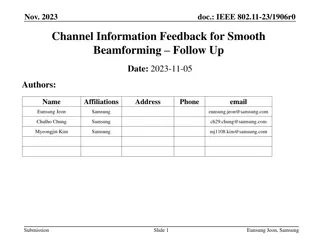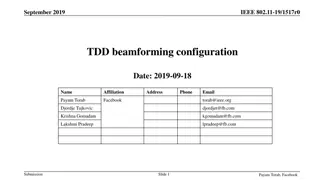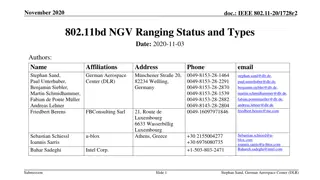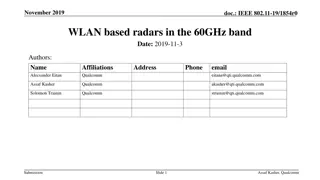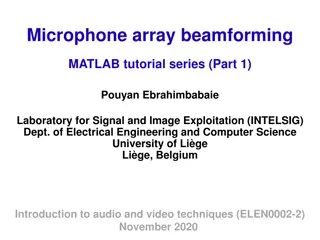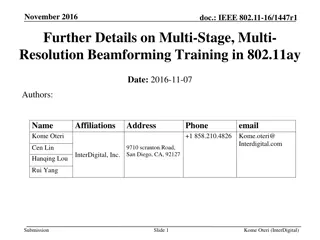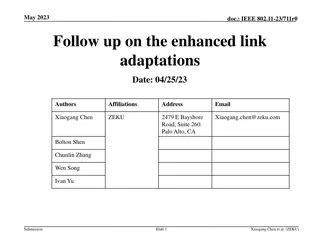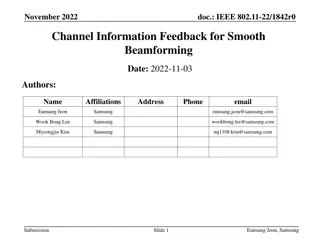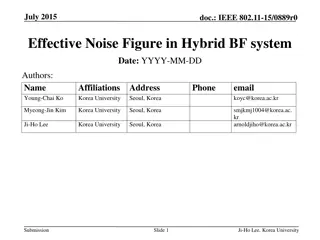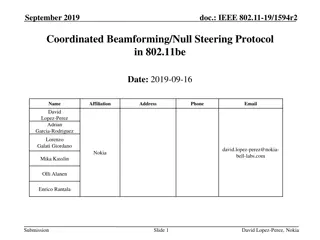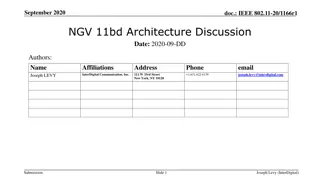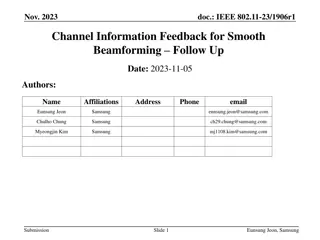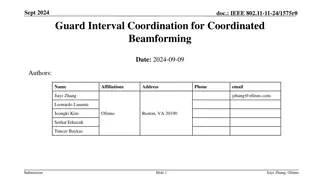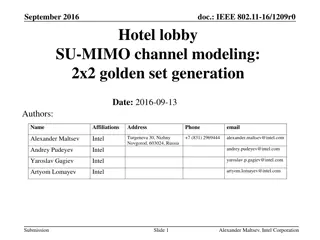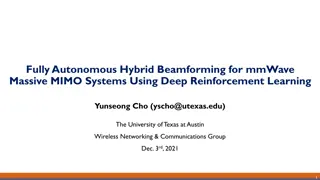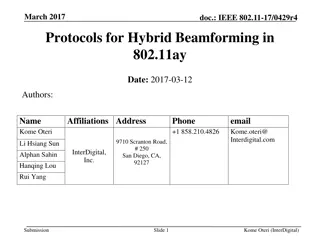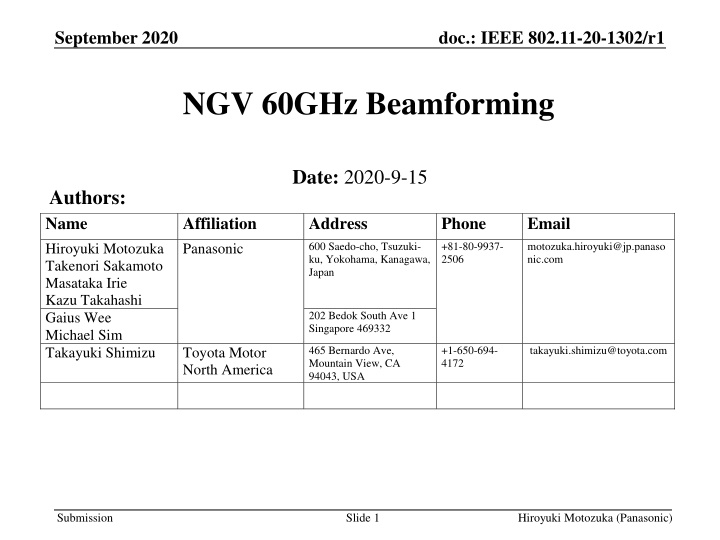
Advanced Beamforming Techniques for 60GHz Communication
Explore the latest advancements in beamforming technology for 60GHz communication, enabling extended communication ranges and improved performance in V2X scenarios. Discover innovative procedures and gain insights into beamforming protocols and implementation. Stay ahead in the realm of high-frequency communication with this cutting-edge research.
Download Presentation

Please find below an Image/Link to download the presentation.
The content on the website is provided AS IS for your information and personal use only. It may not be sold, licensed, or shared on other websites without obtaining consent from the author. If you encounter any issues during the download, it is possible that the publisher has removed the file from their server.
You are allowed to download the files provided on this website for personal or commercial use, subject to the condition that they are used lawfully. All files are the property of their respective owners.
The content on the website is provided AS IS for your information and personal use only. It may not be sold, licensed, or shared on other websites without obtaining consent from the author.
E N D
Presentation Transcript
September 2020 doc.: IEEE 802.11-20-1302/r1 NGV 60GHz Beamforming Date: 2020-9-15 Authors: Name Hiroyuki Motozuka Takenori Sakamoto Masataka Irie Kazu Takahashi Gaius Wee Michael Sim Takayuki Shimizu Affiliation Panasonic Address Phone Email 600 Saedo-cho, Tsuzuki- ku, Yokohama, Kanagawa, Japan +81-80-9937- 2506 motozuka.hiroyuki@jp.panaso nic.com 202 Bedok South Ave 1 Singapore 469332 Toyota Motor North America 465 Bernardo Ave, Mountain View, CA 94043, USA +1-650-694- 4172 takayuki.shimizu@toyota.com Submission Slide 1 Hiroyuki Motozuka (Panasonic)
September 2020 doc.: IEEE 802.11-20-1302/r1 Abstract 60 GHz band transceivers utilize beamforming to achieve practical communication range (several hundreds of meters) in V2X scenarios. Beamformed transmission/reception is suitable for unicast communication. We propose discovery procedure in OCB mode that is required for performing beamforming training and/or beamformed unicast transmission. The concept was proposed in: [1] 11-20/1162r2 OCB for 60GHz Submission Slide 2 Hiroyuki Motozuka (Panasonic)
September 2020 doc.: IEEE 802.11-20-1302/r1 Beamforming gain It is expected to utilize 10 dBi or (much) higher antenna gain in 60 GHz band communication. Beamforming gain is essential to enable the desired communication range (one to a few hundreds meters) for outdoor scenarios. In these scenarios, STAs not in proximity of each other have to perform initial beamforming training before starting data transmission. Typically in 11ad/ay (non-TDD), initial beamforming training is performed during scan procedure. This assumption/situation is different from 5.9 GHz OCB communication. STA w/ beamformed antenna Antenna gain e.g. +10 dB + may have larger power input e.g. +10 dB with larger number of antenna elements (implementation dependent) w/ quasi-omni antenna Submission Slide 3 Hiroyuki Motozuka (Panasonic)
September 2020 doc.: IEEE 802.11-20-1302/r1 Beamforming procedure in BTI (11ad) Beamforming using DMG Beacon frames (BTI) is one of the procedures to be used for the initial beamforming. Sector ID=1 (example) Received SSW frame with the best quality 1) A STA sweeps sectors using multiple DMG Beacon (DBcn) frames 4) Initiator STA transmits SSW-Feedback frame Including feedback: best Sector ID=1 Sector ID 0 1 2 N-1 Initiator STA SSW DBcn DBcn DBcn DBcn SSW-FB Responder STA SSW DBcn SSW SSW Sector ID=2 (example) Received DBcn frame with the best quality Sector ID 0 1 N-1 3) A peer STA sweeps sectors using SSW frames Including feedback: best Sector ID=2 A-BFT slot#0 BTI A-BFT slot#1 A-BFT slot#2... 2) Responder STA chooses one of A-BFT slot by random to perform Tx Sector Sweep Submission Slide 4 Hiroyuki Motozuka (Panasonic)
September 2020 doc.: IEEE 802.11-20-1302/r1 DMG Beacon transmission with Discovery mode = 1 (11ad) 11ad specifies a beacon transmission procedure before establishment of a BSS (802.11-2016[2], subclause 11.1.3.4) DMG Beacon transmission, followed by beamforming training, is performed with random interval to discover peer STA(s). Transmission of DMG Beacon frames (BTI) A-BFT slots waiting for responses from peer STAs STA The Interval should be set to a random duration, about 10 200ms: from 802.11-2016: At each TBTT, the STA should generate a random value for the Beacon Interval field within the DMG Beacon frame from a uniform distribution between [10 TUs, 200 TUs), i.e., 10 TUs to 199 TUs. Submission Slide 5 Hiroyuki Motozuka (Panasonic)
September 2020 doc.: IEEE 802.11-20-1302/r1 Requirements in V2X The procedure in the previous slides (Discovery beacon transmission) seems to be reusable for V2X scenario. What s the difference between 11ad and V2X? 11ad STA STA in V2X/OCB Upon having discovered peer STA(s): The STA proceeds with probing, and establishing or joining a BSS, with stopping of DMG Beacon transmission. Upon having discovered peer STA(s): 1) The STA should start data communication with the discovered STA immediately. 2) The STA should continue transmission of DMG Beacon frames to discover the other, newly approaching STAs. Submission Slide 6 Hiroyuki Motozuka (Panasonic)
September 2020 doc.: IEEE 802.11-20-1302/r1 Proposed procedure of DMG OCB Discovery MAC frame exchange procedure should be reused from BTI with Discovery mode in 11ad. MLME should have primitives to request the MAC entity to start OCB operation with continuous discovery procedure. The MAC entity should indicate the discovered peers info to the higher layer, at least including: MAC address Support of NGV(OCB) operation DMG Beacon transmission with random interval may be continued until the MLME requests to stop the OCB operation. SME MAC Peer MAC Peer SME MLME-DMG-OCB- START.request MLME-DMG-OCB- START.confirm DMG Beacon frames MLME-DMG-OCB- START.request DMG Beacon frames MLME-DMG-OCB- START.confirm DMG Beacon frames DMG Beacon frames DMG Beacon frames DMG Beacon frames (The STAs are approaching...) DMG Beacon frames SSW frames (A-BFT) SSW-Feedback frame (A-BFT) MLME-DMG-OCB- DISCOVERED.indication MLME-DMG-OCB- DISCOVERED.indication DMG Beacon frames DMG Beacon frames MLME-DMG-OCB-STOP.request DMG Beacon frames Submission Slide 7 Hiroyuki Motozuka (Panasonic)
September 2020 doc.: IEEE 802.11-20-1302/r1 Proposed spec changes overview Add a signaling field/element within the DMG Beacon, SSW and SSW-feedback frames to indicate the support of OCB operation in 60GHz. Specify the procedure for MLME and higher MAC based on the figure in the previous slide. The text is proposed in 11-20-1303/r0[4] Submission Slide 8 Hiroyuki Motozuka (Panasonic)
September 2020 doc.: IEEE 802.11-20-1302/r1 Conclusion This submission discusses DMG beamforming for STAs operating OCB. A discovery procedure for DMG STAs operating OCB is proposed. Submission Slide 9 Hiroyuki Motozuka (Panasonic)
September 2020 doc.: IEEE 802.11-20-1302/r1 References [1] 11-19/1162r2 OCB for 60GHz [2] IEEE802.11-2016 [3] 11-19/497r6 802.11bd Specification Framework Document [4] 11-20/1303r0 NGV 60 GHz beamforming - text Submission Slide 10 Hiroyuki Motozuka (Panasonic)
September 2020 doc.: IEEE 802.11-20-1302/r1 Straw Poll Do you support to add the following text to Section 4 of SFD[3]: 11bd shall enable a procedure for continuous discovery of other DMG STAs with dot11OCBActivated equals to true, based on beacon transmission procedure before establishment of a BSS (802.11-2016, subclause 11.1.3.4) The MLME service interface shall be extended to provide higher layers with the ability to continuously discover other DMG STAs with dot11OCBActivated equals to true. 11bd shall enable DMG STAs with dot11OCBActivated equals to true to perform data transmission shortly after discovery. Y /N /A Submission Slide 11 Hiroyuki Motozuka (Panasonic)

